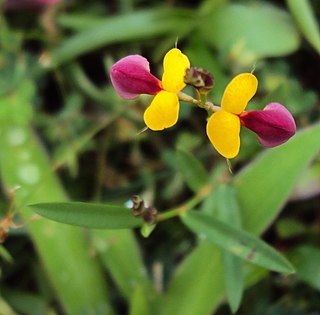
The genus Cajanus is a member of the plant family Fabaceae. There are 37 species, mainly distributed across Africa, Asia and Australasia.

The Asclepiadoideae are a subfamily of plants in the family Apocynaceae. Formerly, it was treated as a separate family under the name Asclepiadaceae, e.g. by APG II, and known as the milkweed family.

The Celastraceae are a family of 98 genera and 1,350 species of herbs, vines, shrubs and small trees, belonging to the order Celastrales. The great majority of the genera are tropical, with only Celastrus, Euonymus and Maytenus widespread in temperate climates, and Parnassia (bog-stars) found in alpine and arctic climates.

Stapeliinae is a subtribe of flowering plants within the tribe Ceropegieae of the subfamily Asclepiadoideae of the family Apocynaceae. The subtribe comprises about 35 genera, including both the stem-succulent "stapeliads" and the horticulturally popular genera Brachystelma and Ceropegia. The largest number of genera are native to Africa, but a more limited number of genera are widespread in Arabia and Asia. Historically, a similarly circumscribed taxon was treated as a separate tribe, Stapelieae.

Alysicarpus is a genus of flowering plants in the legume family, Fabaceae. It is distributed in tropical and subtropical regions of Africa, Asia, and Australia. Species are known generally as moneyworts. Unusually for legumes, the leaves are simple.

Dichrostachys is an Old World genus of flowering plants in the family Fabaceae. Their Acacia-like leaves are bi-pinnately compound. Unlike Acacia their thorns are hardened branchlets rather than modified stipules. They are native from Africa to Australasia, but a centre of diversity is present in Madagascar.

Wendlandia is a genus of flowering plants in the family Rubiaceae. It is found in northeastern tropical Africa, and from tropical and subtropical Asia to Queensland.

Flemingia is a genus of plants in the family Fabaceae. It is native sub-Saharan Africa, Yemen, tropical Asia, and Australasia. In Asia the species are distributed in Bhutan, Burma, China, India; Indonesia, Laos, Malaysia, Nepal, Pakistan, Papua New Guinea, Philippines, Sri Lanka, Taiwan, Thailand and Vietnam. The genus was erected in 1812.

Pseudarthria is a genus of flowering plants in the legume family, Fabaceae. It includes seven species of herbs, subshrubs, and shrubs native to tropical Africa and Asia. Typical habitats are seasonally-dry tropical forest margins, grassland, and open or disturbed areas. It belongs to subfamily Faboideae.
Hedyotis (starviolet) is a genus of flowering plants in the family Rubiaceae. Many species of this genus such as Hedyotis biflora, H. corymbosa and H. diffusa are well known medicinal plants. Hedyotis is native to tropical and subtropical Asia and to islands of the northwest Pacific. It comprises about 115 species. The type species for the genus is Hedyotis fruticosa.

Bruguiera is a plant genus in the family Rhizophoraceae. It is a small genus of five mangrove species and three hybrids of the Indian and west Pacific Ocean region, its range extending from East Africa and Madagascar through coastal India, Sri Lanka and Southeast Asia to northern Australia, Melanesia and Polynesia. It is characterised by calyces with 8-16 lanceolate, pointed lobes, 16-32 stamens, explosive release of pollen, and viviparous propagules. It is named in honour of French explorer and biologist Jean Guillaume Bruguière (1750–1798). Recently, the eighth taxa of Bruguiera, B. × dungarra was recognised as occurring in northern Australia.

Dendrophthoe is a genus of hemiparasitic shrubs found in Asia and Australia known as mistletoes. The genus was described by German naturalist Carl Friedrich Philipp von Martius in 1830. Species in this genus have a variety of reported uses in the medical traditions of the region, most notably in Nepal.

Periplocoideae is a subfamily of the dogbane plant family, Apocynaceae. It was not divided into tribes as of 2014.
Anton Karl Schindler was a German dentist and botanist.
Tetrataenium is a genus of flowering plants belonging to the family Apiaceae.

Decaschistia is a genus of flowering plants belonging to the family Malvaceae.
Hyptianthera is a genus of flowering plants belonging to the family Rubiaceae.

Neanotis is a genus of flowering plants belonging to the family Rubiaceae, and the major group Angiosperms.
Solenocarpus is a genus of flowering plants belonging to the family Anacardiaceae.














